Mission "Chang'e-4" - the third lunar day. Rover "Yuytu-2" in search of ... stones
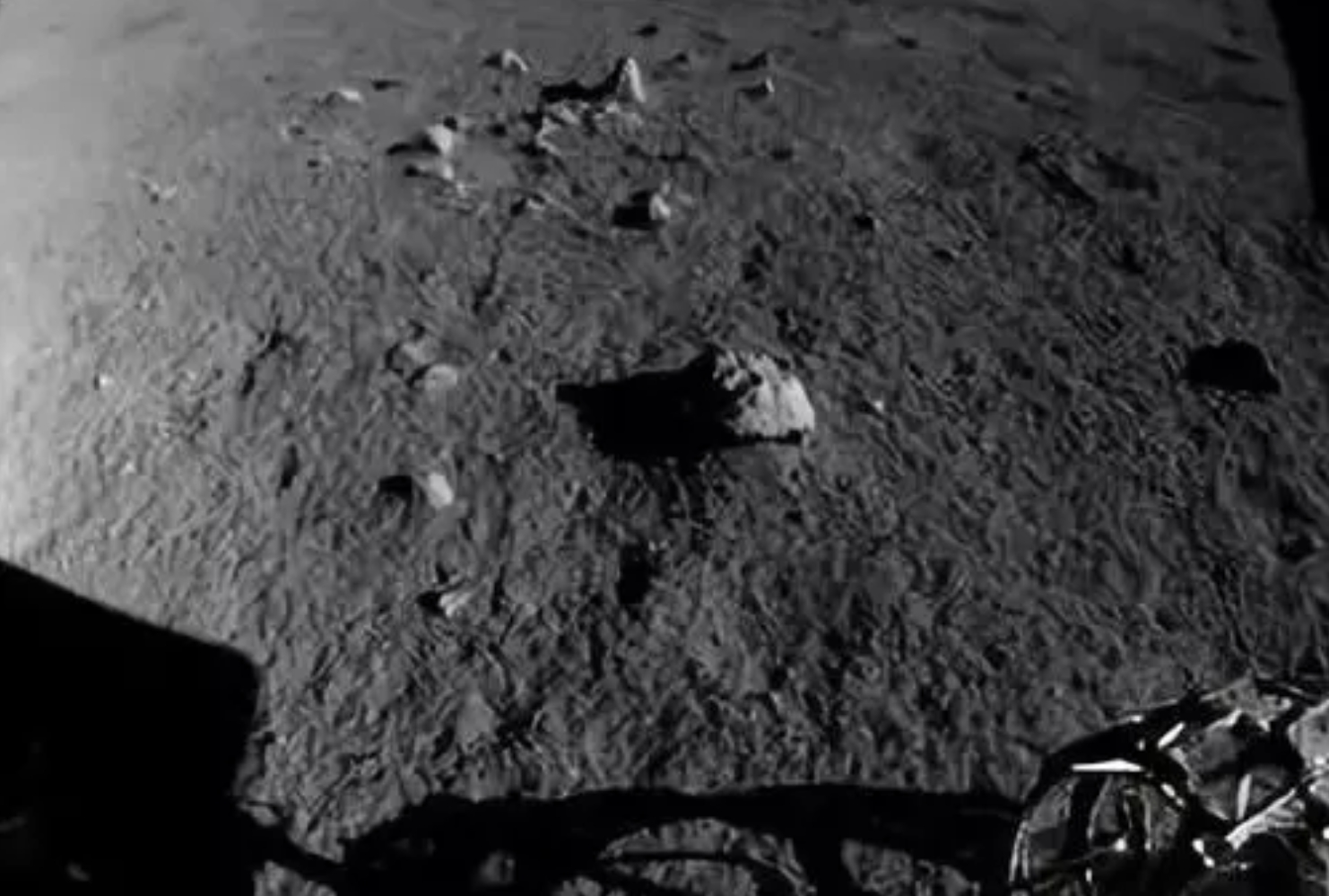
The lunar rover “Yuytu-2” drove 43 meters on the third lunar day, adding them to the 44 (44.185) meters passed on the first lunar day and 76 meters (75.815) on the second lunar day. Total 163 meters covered for three lunar days. Is it a lot or a little? And why does such a short distance pass the moon rover in this mission?
Previously published materials about the mission "Chang'e-4":
1. The spacecraft "Chang'e-4" made a successful landing on the far side of the moon and sent the first photo
2. On-board video of the processes of preparation and landing, as well as the panorama of the far side of the Moon from Chang'e-4
')
3. Video of the descent of the rover "Yuytu-2", its first meters on the surface of the moon. Two week sleep on the moon is over
4. Pride and Passion, the story of turning a dream into a space project
5. NASA lunar orbital probe made the first pictures of the Chinese Chang'e-4 station - two pixels of light
6. Module "Chang'e-4" and rover "Yuytu-2" are ready for the second night on the far side of the moon
7. NASA lunar orbital probe made new images of the China Chang'e-4 station - closer and clearer
8. Interesting facts about the history of the Chinese lunar program and the Chang'e-4 space mission
1. The spacecraft "Chang'e-4" made a successful landing on the far side of the moon and sent the first photo
2. On-board video of the processes of preparation and landing, as well as the panorama of the far side of the Moon from Chang'e-4
')
3. Video of the descent of the rover "Yuytu-2", its first meters on the surface of the moon. Two week sleep on the moon is over
4. Pride and Passion, the story of turning a dream into a space project
5. NASA lunar orbital probe made the first pictures of the Chinese Chang'e-4 station - two pixels of light
6. Module "Chang'e-4" and rover "Yuytu-2" are ready for the second night on the far side of the moon
7. NASA lunar orbital probe made new images of the China Chang'e-4 station - closer and clearer
8. Interesting facts about the history of the Chinese lunar program and the Chang'e-4 space mission
The third lunar day for the Chang'e-4 mission is the period from February 27, 2019 to March 13, 2019:
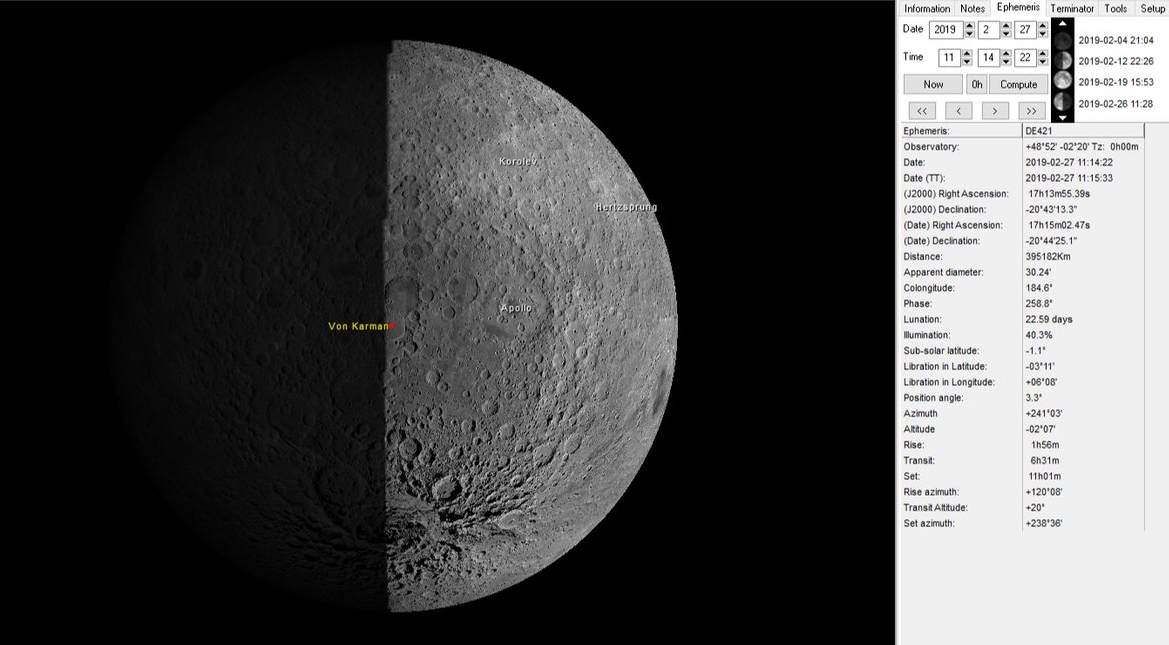
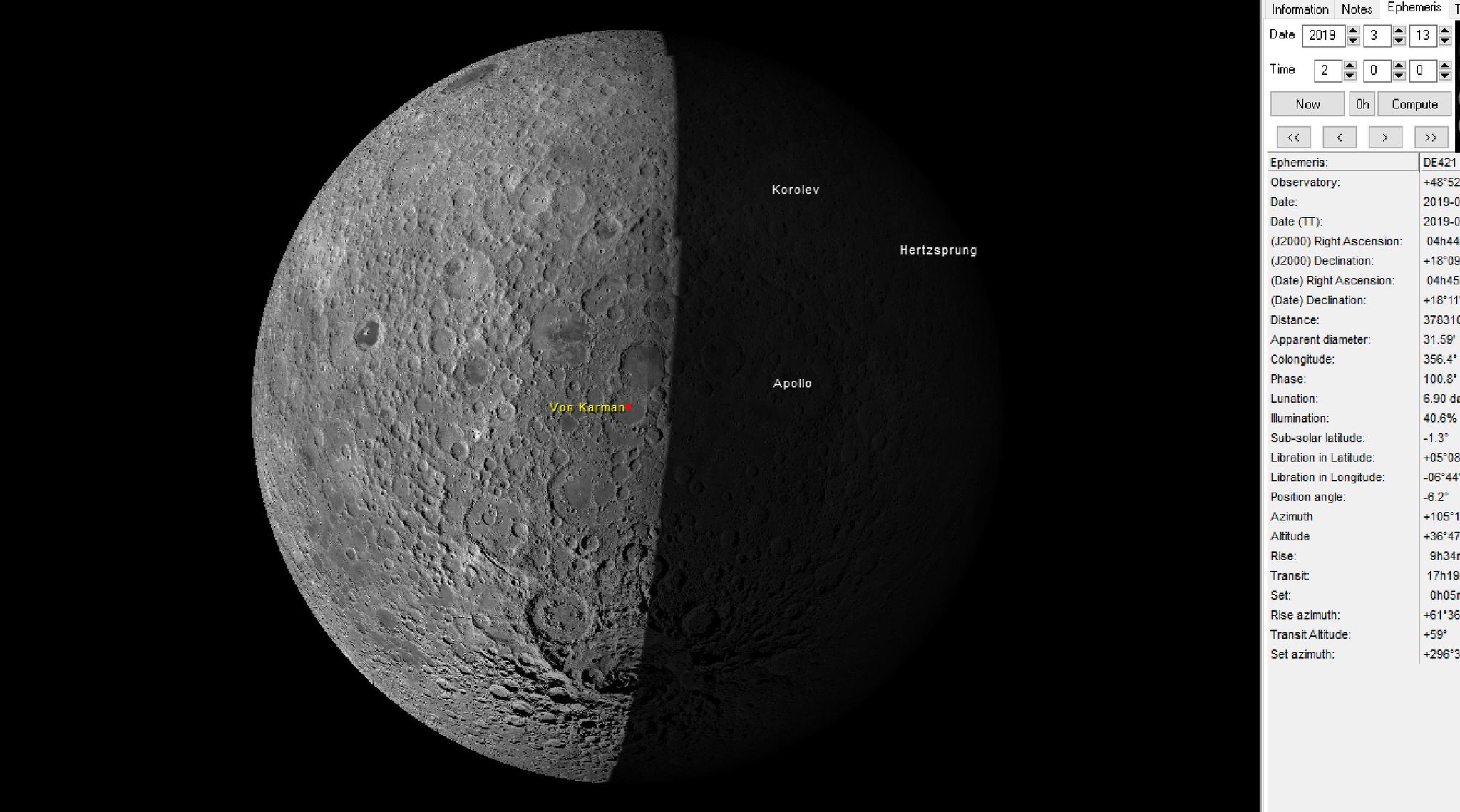
Currently, from March 13, 2019, the equipment of the landing module “Chang'e-4” and the rover “Yuytu-2” are put into sleep mode until the end of the third lunar night to survive the period of extremely low-temperature environment on the far side of the moon.
What is the surface on the back of the moon?

Since the reverse side of the moon also has a more complex relief than the side visible from the earth, the Yuuta-2 rover ran into more serious motor problems and disturbances when it was moving compared to those that its predecessor had previously encountered. Yuytu ", sent to the Moon surface in 2013.
Unfortunately, the first Yutu rover of the Chang'e-3 mission, on January 25, 2014, was technically immobilized (crash of the elements as a result of a collision) after overcoming 114.8 meters on a complex lunar surface.
The lunar surface in the landing zone of the Chang'e-4 landing module is replete with folds, numerous pebbles and small craters. After each small movement is made, the Yuuta-2 rover should stop, take a picture of the surface around and send this data back to Earth via satellite repeater.
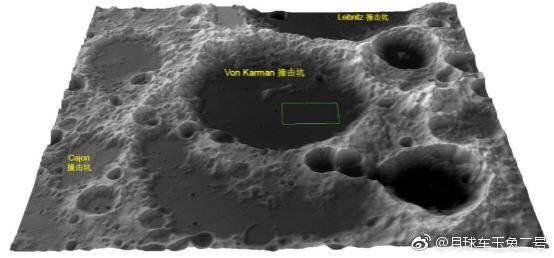
Scientists, operators at the MCC, and engineers on Earth then process this data and schedule a further route that the Yuuta-2 rover will follow.
Antennas of the Yuytu-2 rover must be configured to point at the satellite repeater in order to send and receive control signals correctly, while the rover’s solar panels must be optimally tilted to get a lot of sunlight in order to maximize electricity at the time of the transfer of data.

Six-wheeled Rover "Yuytu-2":
- The total mass of the rover is about 140 kg (310 pounds);
- load capacity - about 20 kg (44 pounds);
- can move on slopes and has automatic sensors that prevent collisions with other objects;
- electricity rover is provided with two solar panels, allowing the rover to work during the lunar day;
- The maximum speed of 200 meters per hour (this speed on the Moon will not be reached anyway - as the elements on the surface will not allow acceleration and disable the rover earlier);
- The maximum study area - 3 square meters. km;
- estimated time of work - 3 months (2160 hours);
- The maximum estimated distance is 10 km.

So far, 70 days have passed (1680 hours) after the landing of the Yuuta-2 rover on the Moon's surface and 97 days (2328 hours) after launching the Yuyuta-2 rocket from the Sichan space center as part of the Chang'e-4 mission to the Moon.
In fact, the Yuuta-2 rover has already developed its calculated working life, but in the event of a successful “awakening” after sleep on March 27, 2019, it is planned that it will continue to engage in surface research on its fourth lunar day.
But how much of its capacity in terms of performance is enough - this is already above the design norm and problems or breakdowns will occur in the nodes and systems, since large temperature drops, radiation, pollution and other lunar external factors will influence its characteristics more strongly with each passing hour.
The trajectory of the rover "Yuytu-2" on the first lunar day and part of the second lunar day:
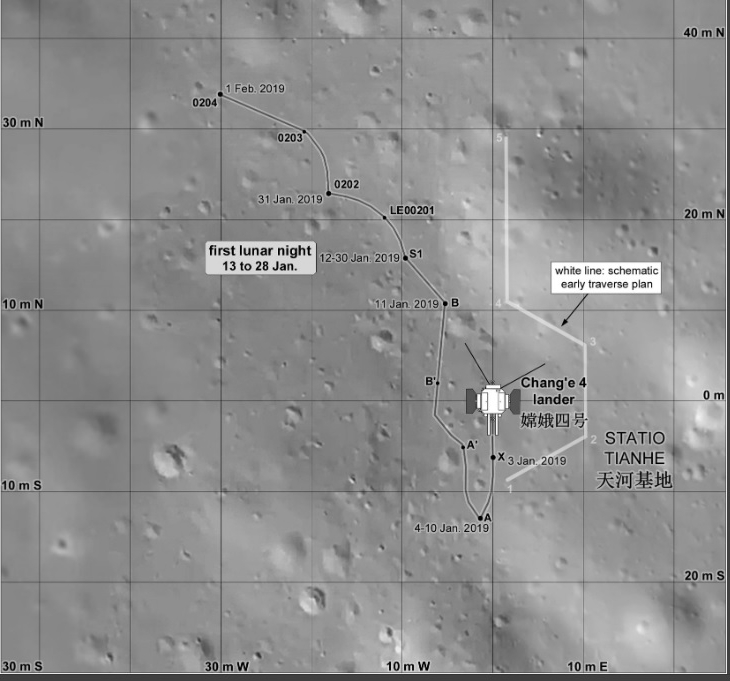
You can check the photos of the landing site, which made the NASA LRO probe from a height of 82 kilometers, a resolution of 0.85 meters (33 inches) per pixel:

At the moment, the Yuytu-2 rover is at a distance of more than 80 meters diagonally from the Chang'e-4 landing module and has already driven 163 meters after its disembarkation.
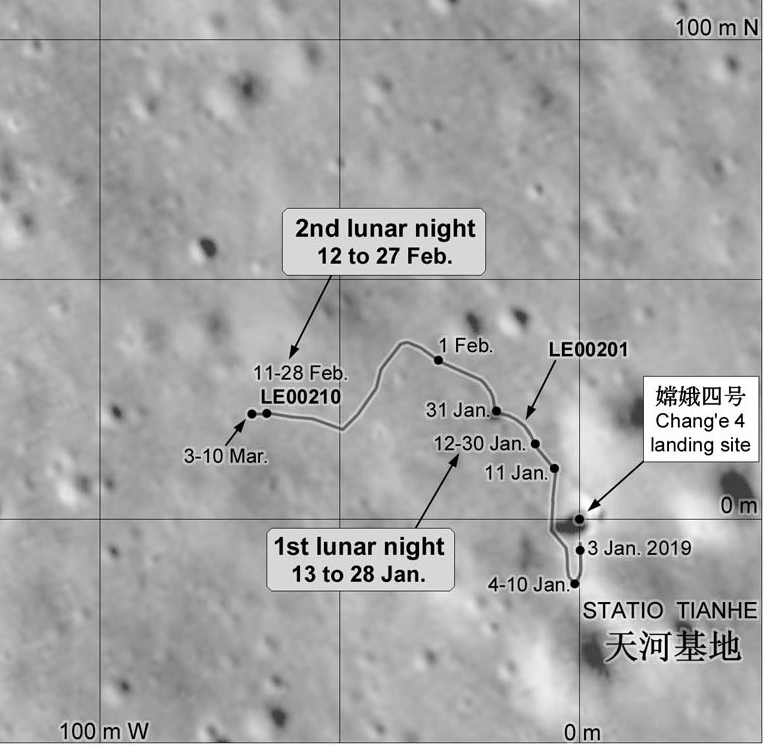
Why did the Yuuta-2 rover drive so little?
Firstly, it is “fear” to immobilize the Yuuta-2 rover (and not to repeat the fate of the first Yuuta rover), so the Yuuta-2 rover must move across the surface of the Moon, carefully avoiding obstacles. Each of his centimeter movement must be done carefully and correctly. In the MCC, the Chang'e-4 missions try to avoid a situation in which the Yuuta-2 rover will turn over, which means that it will not be able to return to its working position again. Solar panels on the sides of the moon rover "Yuytu-2" are very fragile, they can crack or become covered with dust after a fall, which will make them unusable.
Secondly, the reverse side of the moon is more likely to fall into meteorites, so the terrain there is very difficult, on the lunar surface in the landing zone there are a lot of small craters and depressions that need to be driven as far as possible, but still need to move further in search of the ones to be studied. surface elements - large stones and formations. And their search and research of different formations are also necessary and forced stops for conducting research in one place with a long stop time.

Thus, on the first and second lunar day, a detailed map of the landing area and possible further route of the rover, which turned out to be much more convoluted than the previously planned direct route, were also being finalized using data from the onboard chambers of the Yuuta-2 rover.
On the third lunar day, the “Yuuta-2” rover reached the place with interesting formations on the lunar surface - sharp peaks on the surface, medium and large detached stones.
Elements of the landscape on the back of the lunar surface may be older than similar ones on the visible side, so studying the soil and stones on the back side may shed more light on the origin and evolution of the moon.
Who controls the “Yuytu-2” rover?
Telemetry, data from cameras and scientific equipment, control teams and round-the-clock monitoring of the parameters of the Yuuta-2 rover are the prerogatives of the engineers of the aerospace control center of the Chinese Academy of Space Technology.
In China, the moon is traditionally associated with women, the Chinese program for researching the moon is also named after the goddess of the moon, Chang'e, which emphasizes the contribution of women scientists and engineers to the development of space research.
In the Chinese legend, a girl named Chang'e flew to the moon and became a goddess there, but she cannot return to Earth to reunite with her husband.
The girls-engineers of the Aerospace Control Center of the Chinese Academy of Space Technology were more fortunate - many of them have the opportunity to fly “virtually” to the Moon and be on Earth with their loved ones at the same time.
It turns out that women from the engineering team for managing the Yuuta-2 rover have a stronger sense of responsibility and perseverance than many of their male colleagues, they are more demanding and observant to the smallest details in the process of working with the Yuuta-2 rover . Therefore, among the group of engineers-operators of the rover "Yuytu-2", they can maximize the scientific and engineering talents in their work.
Verification of telemetry data with a colleague:
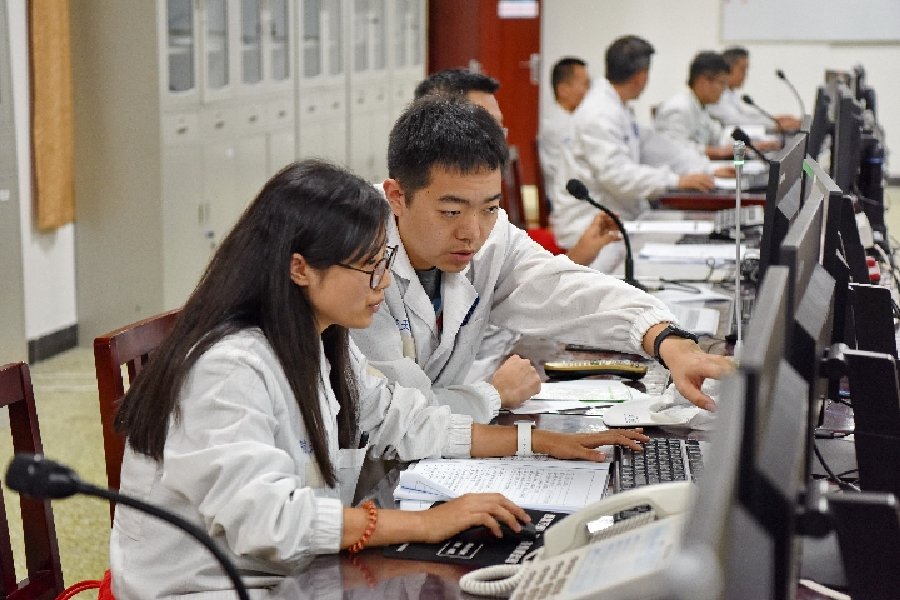
Workplace operator rover "Yuytu-2":

Now back to the rover "Yuytu-2."
More than three billion years ago, the reverse surface of the moon was bombarded by large asteroids and meteorites, which caused a global change on its surface, traces of this process, and is studying the Yuuta-2 rover.
The onboard cameras of the “Yuytu-2” rover are stationary, to obtain the desired images, it is necessary to perform precise movement and adjustment of the horizontal position, as well as compensation for the angle of inclination of the rover itself, which takes a lot of time for the operators in the MCC. After all, the surface in the landing zone of the “Yuuta-2” rover is littered with craters of various sizes, which makes it very difficult to move safely.
It turns out that the “Yuuta-2” rover is able to automatically circumvent some obstacles, if there is a big stone or a crater in front of it, it can independently stop and plan a new route to bypass this place, in this case, the operator at the MCC can register this situation and restructure the planned route to a new one.
Rooster "Yuytu-2" can also climb on small slopes and cross the rocky surface. But the main front of his work - the movement on a flat horizontal surface and the lunar soil.
So what kind of device is this “VNIS spectrometer” installed aboard the “Yuytu-2” rover?
The VNIS (The Visible and Near-Infrared Imaging Spectrometer) lunar infrared spectrometer was developed at the Shanghai Technical Physics Institute of the Chinese Academy of Sciences.
The spectrometer uses non-collinear acousto-optic tunable filters, it consists of a VIS / NIR video spectrometer (0.45–0.95 μm) and a short-wave IR spectrometer (0.9–2.4 μm), it also has a calibration block with protection from dust and dirt.
The spectrometer is installed on the front aboard the Yuuta-2 rover and has the following limitations on positioning and working with lunar material:
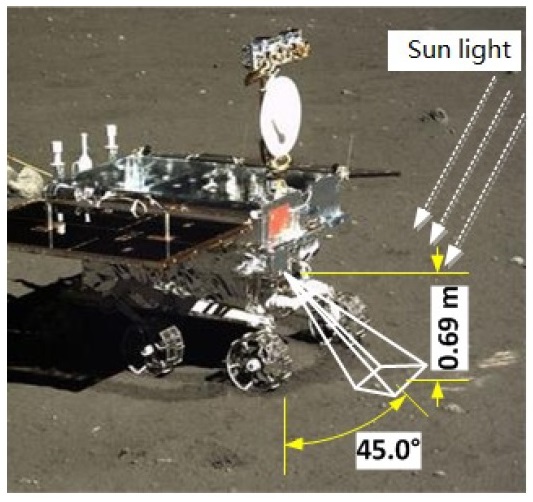
Minerals, such as pyroxene, plagioclase, olivine and ilmenite, which constitute the majority of lunar surface rocks, have distinctive spectral characteristics:

The structural scheme of the spectrometer:
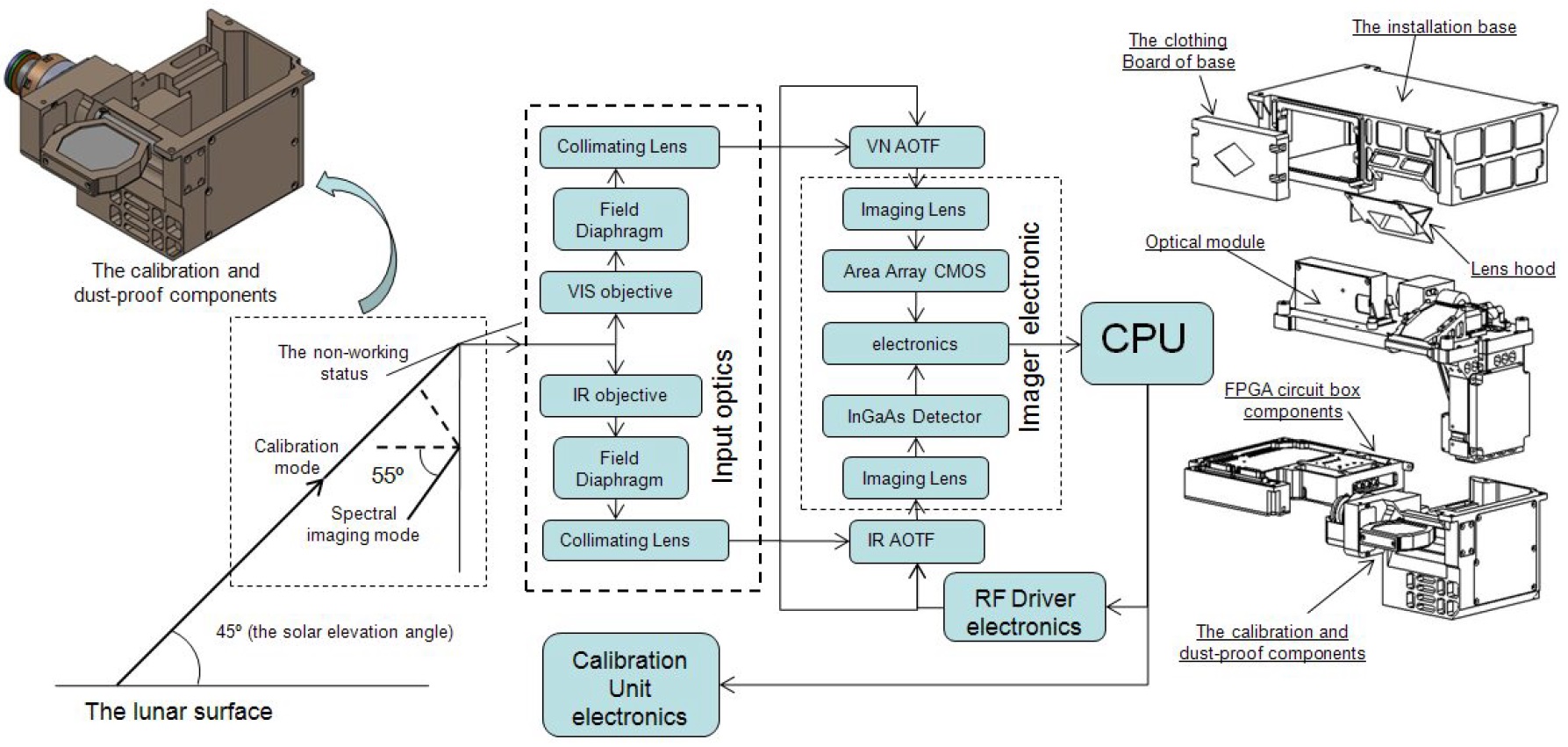
Main technical characteristics of the spectrometer:

The appearance of the spectrometer:
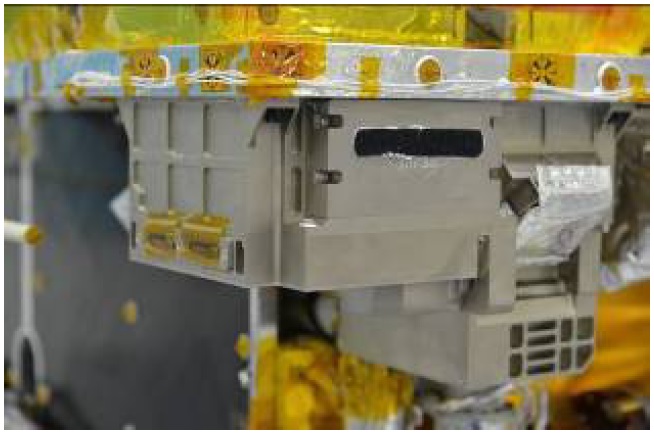
Geometrical dimensions of the detection window:

The data obtained by the spectrometer:
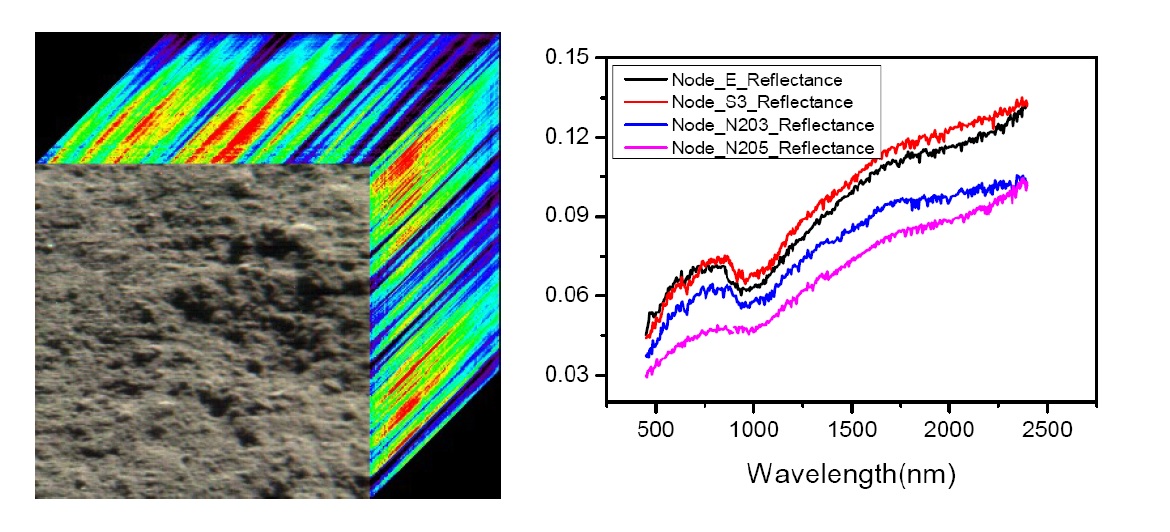
On the third lunar day, the Yuuta-2 rover was engaged in obtaining scientific data using an on-board VNIS (Visible and Near-Infrared Imaging Spectrometer) stationary spectrometer, whose sensor’s field of view is only a few centimeters, so the rover must be positioned very accurately and accurately. Yuytu-2 ”, so that the spectrometer“ eye ”can be displayed on the desired portion of the lunar surface to obtain correct data from the optimal distance.
After his short walk on the moon, the Yuuta-2 rover reached an interesting stone “clearing”, in the center of which a large stone with a diameter of 20 centimeters was found. Scientists were immediately interested in this find, its origin (meteorite, lunar formation) and the process of formation.
General view of the surface panorama during the search for stones:
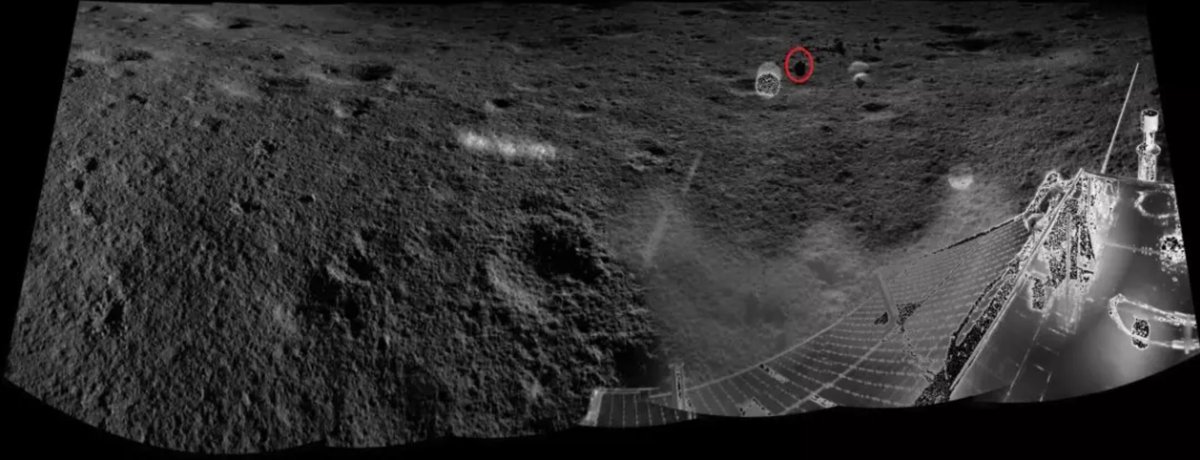
Stony surface, to a large stone (its diameter is 20 centimeters) a distance of 120 centimeters:
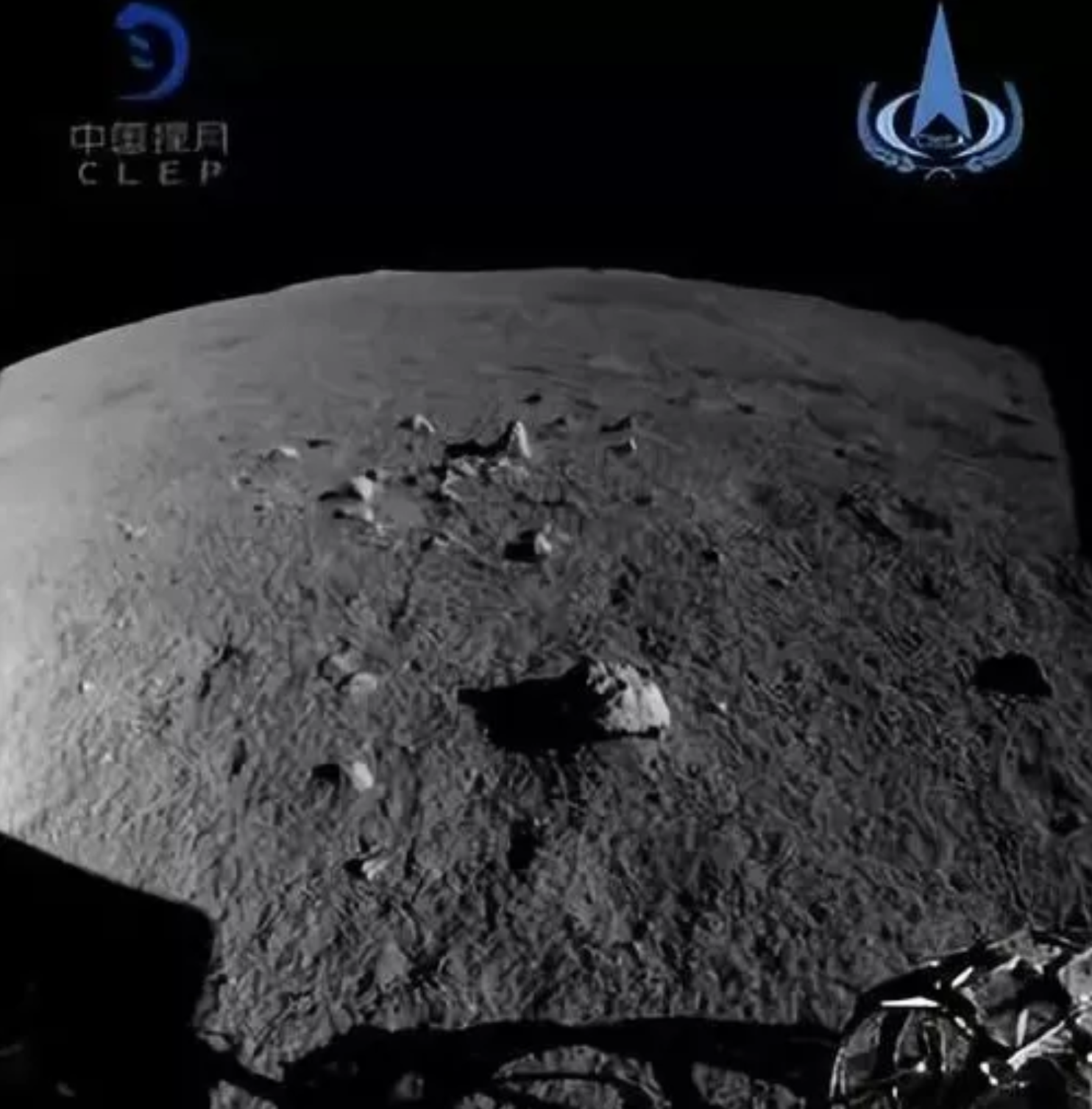
Large image of a large stone:
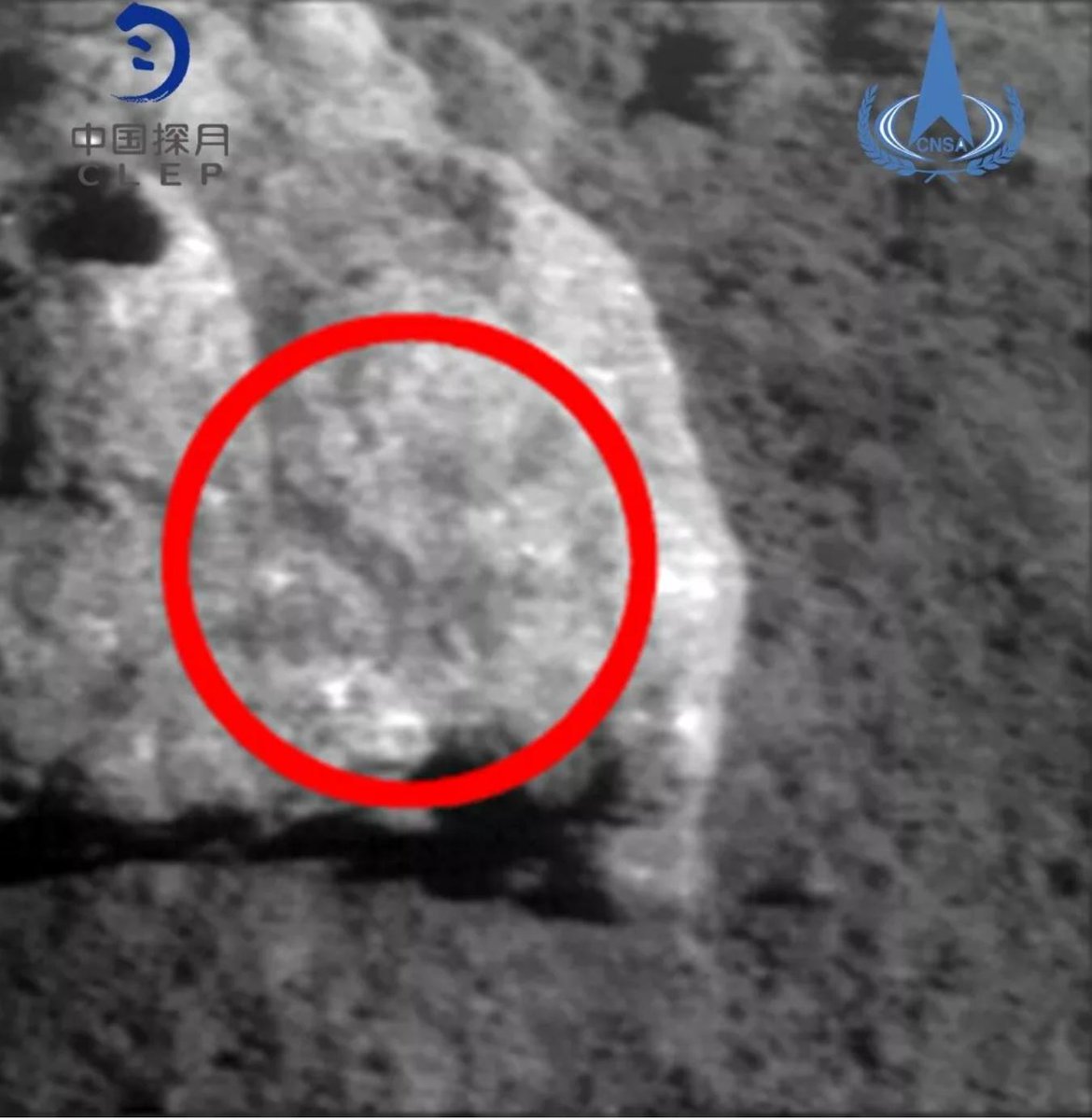

Work with a spectrometer:


Further, the data with the spectrometer of the rover “Yuuta-2” are transmitted to the aerospace control center of the Chinese Academy of Space Technologies, where they are analyzed, stored and will be opened to the scientific community.
The Chinese portal "System of publications and collection of scientific data and studies of the lunar and deep space" has also earned, on which the obtained data and images from Chang'e-4 (and earlier missions) will be published and processed.
Path to the portal :
http://202.106.152.98:8081/moondata/
The data volume is also an interesting point, for example, the “Yuuta-2” rover, after performing measurements with a spectrometer at four different points on the lunar surface, transmitted a total amount of data of 350 MB in size.
Scientific measurements of the elements of the lunar surface and data transfer from the instruments of the Yuytu-2 rover are planned to continue on the fourth lunar day.
Source: https://habr.com/ru/post/443708/
All Articles